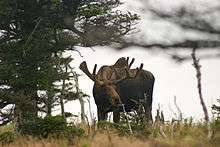Eastern moose
| Eastern moose | |
|---|---|
 | |
| Scientific classification | |
| Kingdom: | Animalia |
| Phylum: | Chordata |
| Class: | Mammalia |
| Order: | Artiodactyla |
| Family: | Cervidae |
| Subfamily: | Capreolinae |
| Genus: | Alces |
| Species: | A. alces |
| Subspecies: | A. a. americana |
| Trinomial name | |
| Alces alces americana | |
The eastern moose (Alces alces americana) is a subspecies of moose. that ranges throughout most of Eastern Canada and most of the New England states and northern New York. Eastern moose inhabit boreal forests and mixed deciduous forests, which provide camouflage from predators which are timber wolves and poachers. The eastern moose is the third largest North American subspecies of moose, behind the western moose and the Alaskan moose. Male eastern moose along with all the other moose species are extremely aggressive during mating season and will attack anything that provokes it.
Range and Distribution
The eastern moose ranges from the Canadian provinces of New Brunswick, Newfoundland (not including Labrador), Nova Scotia, Quebec, and Eastern Ontario. In the United States, it inhabits Maine, New Hampshire, Vermont, Massachusetts, Connecticut, and northern New York state. Eastern moose that roam in Cape Breton Highlands National Park are descended from the western moose that originated from Alberta's Elk Island National Park. The population and range of the eastern moose increased in the decades leading up to the early 2000s as reforestation increased habitat area, but in more recent years diseases and parasites, including winter tick and brainworm, have cut into the population.[1][2]
There are about 350,000 eastern moose, with about 3⁄4 of them mating every autumn and winter.
Habitat
Eastern moose live in thick boreal or mixed forest near large amounts of food. In the summer, they move to have access to wetlands and aquatic vegetation, and prefer temperatures under 15 Celsius.[3][4]
Diet
Eastern moose have a diet similar to that of the other moose species and includes terrestrial vegetation forbs and shoots from trees such as willow and birch. Eastern moose can consume 32 kg in a day. Eastern moose also forage for aquatic plants such as lilies and pondweed during the spring and summer.[5] Like other moose species, eastern moose lack upper front teeth but have eight sharp incisors on their lower jaw.
Size and weight
Male eastern moose stand on average 1.7–2.0 m (5.6–6.6 ft) at the shoulder. Eastern moose antlers have an average span of about 1.5m (5–6 ft) across. The weight of a male eastern moose averages about 634 kg (1,398 lb). Female eastern moose stand on average 1.7m (5–6 ft) at the shoulder and weigh 270–360 kg (600–790 lb). Eastern moose are the third largest subspecies of moose only behind the western moose and the Alaskan moose.
Social structure and reproduction
Eastern moose are solitary most of the year and only come into contact with other individuals either to mate or for two bull moose to fight for breeding rights. Female eastern moose are mostly peaceful towards humans unless she has calves with her. She will attack anything that is within her territory. Like other moose species, male eastern moose use mating calls to attract females to mate with or to challenge another bull moose for mating rights. At 10–11 months, yearling moose are chased off by their mothers to fend for themselves.
Hunting
Eastern moose are hunted for food and sport during autumn and winter.[6]
References
- ↑ Northern Woodlands: "Declining Moose Population" Spring 2015
- ↑ Sreenivasan, Hari (2014-04-07). "Researchers track New Hampshire moose in hopes of pinpointing cause of population decline". PBS Newshour. NewsHour Productions LLC. Retrieved 2016-10-11.
- ↑ "Mooseworld: Moose Habitat". mooseworld.com. Retrieved 2016-03-24.
- ↑ "Eastern Moose" (PDF).
- ↑ "Moose Fact Sheet". Connecticut Environmental Protection. Retrieved 12 December 2011.
- ↑ "Newfoundland Moose Hunting". Newfoundland Hunting. Archived from the original on June 19, 2009. Retrieved 9 April 2016.